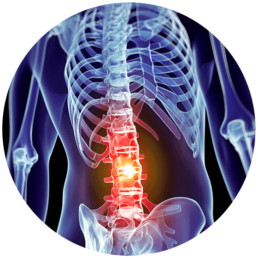Spondylolisthesis

Spondylolisthesis Symptoms & Treatment Options
Spondylolisthesis is a condition that occurs when one vertebra in the spine slides forward over the vertebra that sits beneath it. This most commonly occurs in the lumbar region of the spine, or the lower back. This spinal segment is more prone to injury because it routinely participates in rotating the torso and in lifting heaving objects. Although lumbar spondylolisthesis is most common, slippage can also occur in the cervical or thoracic spine.
The amount of vertebral slippage can occur at different grades or intensities. Your doctor may break down your condition into one of five grades based upon the severity of the movement. Grade 1 involves 25% forward slippage, or movement that’s a quarter of the way off the front edge of the lower vertebrae. Similarly, Grade 2 involves 50% forward slippage; Grade 3 involves 75% slippage; Grade 4 involves 100% slippage; and, Grade 5 indicates that the vertebra has completely fallen off of the vertebra beneath it.
If you or someone you know is experiencing any of the symptoms listed below, you may have spondylolisthesis:
A dull or intense pain, especially in the lower back or neck depending upon location of the slip.
An increase in the visibility of lordosis or swayback.
Pain, weakness, tingling, or the loss of sensation in one or both of the arms or thighs.
Muscular tension in the hamstrings or lower back, with back spasms possible.
A change in the way that person stands or walks, such as developing a waddling gait.
Loss of control of the bladder or bowels. These symptoms require urgent attention.
Symptoms of Spondylolisthesis
Spondylolisthesis can result in bone-on-bone contact or nerve and spinal cord compression. Depending upon the degree to which nerve function is disrupted, you may experience anywhere from mild to debilitating symptoms. On the other end of the spectrum, individuals with spondylolisthesis may experience no symptoms at all. Or, your symptoms may show up years later. Sometimes, the only way to identify if one has spondylolisthesis is to accidentally discover it during the course of an X-ray or an MRI that was taken to assess another spinal condition.
If you are experiencing any of these symptoms, please contact the Advanced Spine Center to schedule an appointment. Dr. Jason E. Lowenstein, director of the spinal deformity center at Morristown Medical Center, specializes in treating conditions like spondylolisthesis. Recognized as a Top Doctor, Dr. Lowenstein will work with you to develop an individualized treatment plan that delivers long-term relief from spondylolisthesis.
Causes & Types of Spondylolisthesis
There is not simply one cause of spondylolisthesis, but rather, five main reasons why vertebral slippage may occur.
Congenital Spondylolisthesis is a condition that is present at birth and results in a defect in the facets joints. The facets are the joints connecting vertebrae that allow for spinal movements from side to side or forward and back. When these joints are incorrectly formed at birth, the facet joints are more prone to instability or fracture, which can cause spondylolisthesis.
Isthmic Spondylolisthesis is only slightly less common, and involves a defect in the part of the vertebra called the isthmus, or pars interarticularis. These pieces of bone connect the facet joints on the backside of our spine. The pars interarticularis is most prone to fracture in children between the ages of 5-7 years old, which often leads to pediatric spondylolisthesis.
Degenerative Spondylolisthesis can occur as a result of the aging process as bones and spinal tissues lose their integrity over time. This degeneration is caused by the forces of gravity and the normal wear-and-tear that the spine accumulates over the years. Arthritis can play a factor in this degeneration. As our bones and tissues degrade, these degenerative processes lead to more chances for instability, friction, compression, and slippage.
Traumatic Spondylolisthesis occurs when an accident or sudden impact results in injury to the spine. Events such as car accidents, falls, and sports injuries can cause damage to spinal structures that may lead to vertebral slippage. Many athletes, even young children, can experience spondylolisthesis because of the quick-pivoting movements associated with sports such as gymnastics and football.
Pathologic Spondylolisthesis involves a disease or condition that leads to degeneration of the vertebrae. This can include spinal tumors or rheumatoid arthritis, both of which can lead to the progressive deterioration of spinal structures and tissues.
Looking for Spondylolisthesis Relief?
Concerned that you—or your child—might be suffering from a slipped vertebra? Our team of Top Doctors includes past award recipients of NJ’s Favorite Kid Doctors & The Patient’s Choice awards. Equally committed to surgical excellence and compassionate care, our fellowship-trained surgeons design a variety of surgical and nonsurgical treatment plans for spondylolisthesis and other painful conditions of the spine.